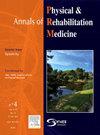Predictors and outcomes of sleep problems following childhood traumatic brain injury: A prospective cohort study
IF 4.6
3区 医学
Q1 REHABILITATION
Annals of Physical and Rehabilitation Medicine
Pub Date : 2025-04-21
DOI:10.1016/j.rehab.2025.101958
引用次数: 0
Abstract
Background
Sleep problems are a relatively common and disabling consequence of childhood traumatic brain injury (TBI). However, few studies have evaluated factors associated with persistent sleep problems or their effects on subsequent behavioral difficulties. Understanding these associations can inform the focus and timing of post-injury interventions and monitoring.
Objectives
This study aimed to identify early risk factors associated with sleep problems 1 year after childhood TBI, and the prospective associations between such sleep problems and subsequent internalizing and externalizing behavioral difficulties 2 years post-injury.
Methods
This longitudinal observational cohort study included children aged 5–15 who received emergency department care for TBI and matched community controls. Baseline measures of pre-injury child functioning were administered within 1 week of injury. Post-injury sleep problems were assessed after 1 year, and internalizing/externalizing behavioral difficulties after 2 years, using well-validated symptom rating scales, including the Child Behavior Checklist sleep problems composite and internalizing/externalizing broadband scales.
Results
The cohort comprised 144 children, categorized into three groups: 63 with mild TBI, 38 with moderate-to-severe TBI, and 43 community controls. The moderate-to-severe TBI group displayed higher levels of sleep problems compared to controls (mean difference, M diff, 0.68; 95 % CI 0.34–1.33) and children with mild TBI (M diff 0.72; 95 % CI 0.13–1.31). In multivariable adjusted models, lower family functioning (B 0.18; 95 % CI 0.05–0.32) and increased TBI severity (B -0.02; 95 % CI −0.03 to −0.01) were predictive of elevated sleep problems at 1-year post-injury. Furthermore, increased sleep problems at 1-year post-injury predicted higher internalizing and externalizing behavioral difficulties at 2 years post-injury after controlling for baseline sleep scores, pre-injury behavioral problems, age, sex, TBI severity, socioeconomic status, and family functioning.
Conclusions
This study underscores the need to address sleep problems in routine clinical screening, post-injury surveillance, and early preventive interventions after childhood TBI. Further research is warranted to evaluate whether family-centered, sleep-focused interventions can mitigate these problems and prevent the onset of later behavioral difficulties in children with TBI.
儿童创伤性脑损伤后睡眠问题的预测因素和结果:一项前瞻性队列研究
睡眠问题是儿童创伤性脑损伤(TBI)的一个相对常见和致残的后果。然而,很少有研究评估与持续睡眠问题相关的因素或它们对随后的行为困难的影响。了解这些关联可以告知损伤后干预和监测的重点和时机。目的本研究旨在确定儿童脑外伤后1年与睡眠问题相关的早期危险因素,以及这些睡眠问题与损伤后2年随后的内化和外化行为困难之间的潜在关联。方法本纵向观察队列研究纳入了5-15岁因脑外伤接受急诊科护理的儿童和匹配的社区对照。损伤前儿童功能的基线测量在损伤后1周内进行。使用经过验证的症状评定量表,包括儿童行为检查表睡眠问题综合量表和内化/外化宽带量表,在1年后评估损伤后睡眠问题,2年后评估内化/外化行为困难。结果该队列包括144名儿童,分为三组:63名轻度TBI, 38名中度至重度TBI, 43名社区对照组。与对照组相比,中度至重度脑外伤组显示出更高水平的睡眠问题(平均差异,mdiff, 0.68;95% CI 0.34-1.33)和轻度TBI儿童(M差0.72;95% ci 0.13-1.31)。在多变量调整模型中,较低的家庭功能(B 0.18;95% CI 0.05-0.32)和TBI严重程度增加(B -0.02;95% CI(- 0.03 ~ - 0.01)预测损伤后1年睡眠问题升高。此外,在控制了基线睡眠评分、损伤前行为问题、年龄、性别、TBI严重程度、社会经济地位和家庭功能后,损伤后1年睡眠问题的增加预示着损伤后2年内化和外化行为困难的增加。结论本研究强调了在常规临床筛查、损伤后监测和儿童脑外伤后早期预防干预中解决睡眠问题的必要性。需要进一步的研究来评估以家庭为中心、以睡眠为中心的干预措施是否能减轻这些问题,并预防创伤性脑损伤儿童后来出现的行为困难。
本文章由计算机程序翻译,如有差异,请以英文原文为准。
求助全文
约1分钟内获得全文
求助全文
来源期刊

Annals of Physical and Rehabilitation Medicine
Medicine-Rehabilitation
CiteScore
7.80
自引率
4.30%
发文量
136
审稿时长
34 days
期刊介绍:
Annals of Physical and Rehabilitation Medicine covers all areas of Rehabilitation and Physical Medicine; such as: methods of evaluation of motor, sensory, cognitive and visceral impairments; acute and chronic musculoskeletal disorders and pain; disabilities in adult and children ; processes of rehabilitation in orthopaedic, rhumatological, neurological, cardiovascular, pulmonary and urological diseases.
 求助内容:
求助内容: 应助结果提醒方式:
应助结果提醒方式:


